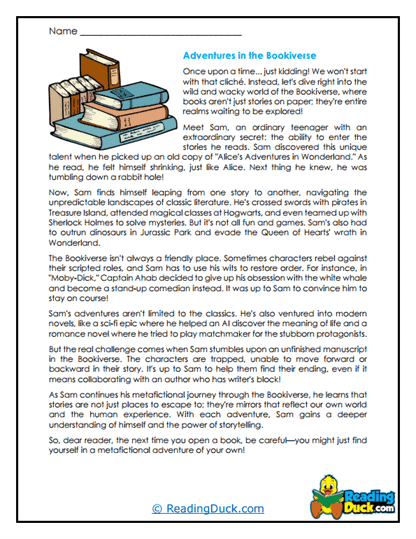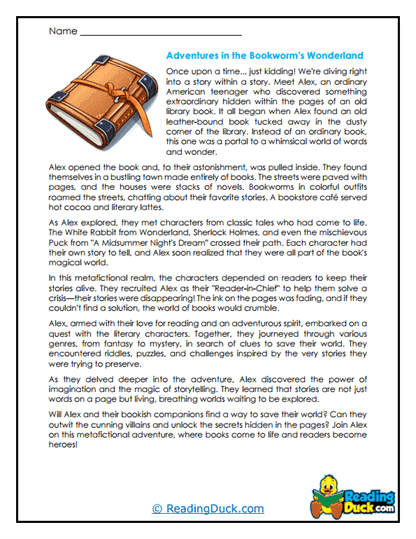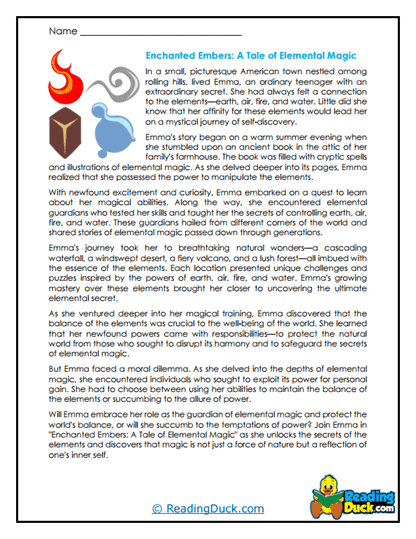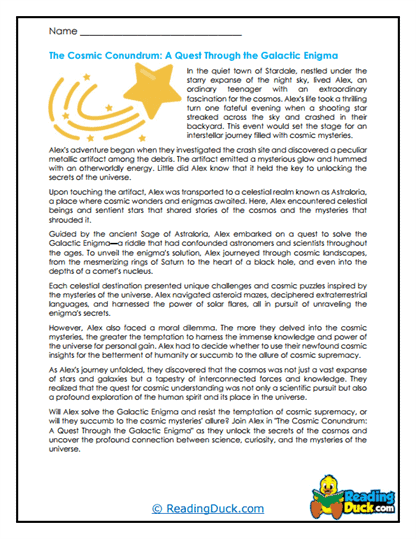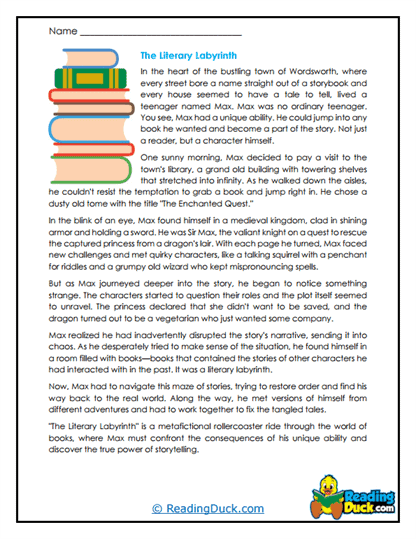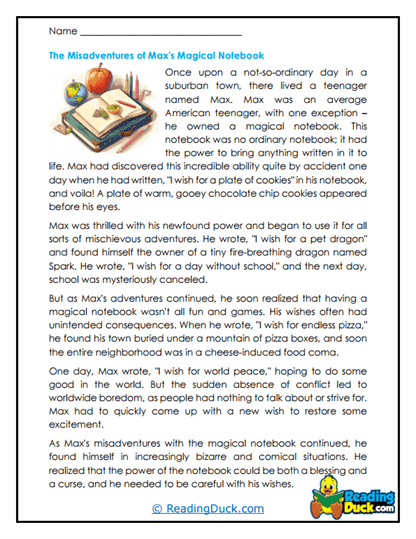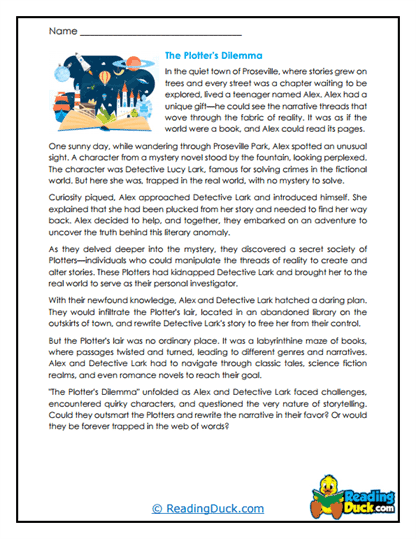Metafiction Worksheets
About Our Metafiction Worksheets
Our Metafiction Worksheets are designed to immerse students in one of the most thought-provoking and innovative genres of fiction. Metafiction is known for its self-reflective nature, often breaking the traditional boundaries between the reader and the narrative. Each worksheet set in this collection features a carefully chosen reading passage that exemplifies the metafiction genre, followed by a variety of multiple-choice questions, short-answer prompts, and open-ended responses. These activities encourage students to engage deeply with the text, analyzing the unique storytelling techniques and themes that make metafiction so distinctive.
These worksheets are presented in a PDF format, making them easy to download, view, and print. They come with a downloadable answer key for quick grading and assessment, helping educators save time while still providing rich learning experiences. Ideal for middle school and high school students, these worksheets can also be adapted for upper elementary learners. Whether used in a traditional classroom, homeschooling environment, or for independent study, they are a versatile resource for exploring the fascinating layers of metafiction.
The Unique Characteristics of Metafiction
Metafiction is a genre that self-consciously reflects on the act of storytelling, often questioning the relationship between fiction and reality. This narrative form frequently breaks the "fourth wall," addressing the reader directly or drawing attention to its own fictional status. It challenges conventional narrative structures, and the text itself often becomes a topic for discussion within the story.
Key characteristics of metafiction include:
- Self-awareness: The text openly acknowledges its own fictionality, sometimes involving the reader in the storytelling process.
- Non-linear or fragmented structure: Metafiction often avoids traditional plot structures, playing with time, sequence, and narrative flow.
- Breaking the fourth wall: Characters or the narrator may directly address the reader or comment on the story itself.
- Exploration of fiction vs. reality: These stories often blur the boundaries between what is real and what is fictional, creating a layered experience for the reader.
Metafiction is essential to fiction because it pushes the boundaries of traditional narrative techniques. By doing so, it encourages readers to think about the nature of storytelling, the role of the author, and the interaction between fiction and the real world. Authors like Jorge Luis Borges, Italo Calvino, and Kurt Vonnegut have used metafiction to question the reliability of narrators, explore alternate realities, and critique literary conventions. This makes metafiction a powerful tool for critical thinking and intellectual engagement, which is why it is such an important genre for students to explore.
Developing Core Skills Through Metafiction
Our Metafiction Worksheets are more than just a tool for reading practice—they’re designed to help students develop a range of important academic skills, from reading comprehension to analytical thinking and creative expression. Here’s how these worksheets help students grow:
- Reading Comprehension: Multiple-choice questions check students' understanding of key details, character actions, and the unusual narrative techniques that are common in metafiction. Students must pay close attention to subtle narrative shifts and self-referential moments.
- Critical Thinking: Short-answer questions challenge students to think about how metafictional techniques—such as breaking the fourth wall—impact their reading experience. They may be asked to reflect on how the text’s self-awareness influences their perception of the story or to analyze the author’s intentions behind these unconventional choices.
- Creative Expression: Open-ended questions inspire students to engage creatively with the text, inviting them to imagine alternate plot developments, create metafictional elements of their own, or even write from the perspective of a character who knows they’re part of a story.
For example, after reading a passage where the narrator openly discusses the challenges of storytelling, students may be asked in a short-answer prompt to explain how this self-reflection changes their understanding of the character’s journey. Open-ended questions might ask students to write a brief narrative in which a character becomes aware they are part of a story, encouraging them to experiment with the core techniques of metafiction.
Engaging with Metafiction’s Complex Narrative Techniques
Metafiction is a genre that thrives on playfulness and experimentation, and our worksheets are designed to encourage students to explore these unique narrative techniques. These activities will engage students in examining how metafiction challenges traditional storytelling, creating a deeper understanding of how fiction can reflect on itself.
Some of the techniques students will explore include:
- Non-linear storytelling: Metafiction often plays with time and sequence. A passage might jump between different points in time, or the story might fold back on itself. In our worksheets, students will analyze how these shifts affect their perception of the plot and characters.
- Breaking the fourth wall: Characters or narrators may address the reader directly, blurring the line between the story and the reader's reality. Students will be asked to reflect on how this technique alters their engagement with the text and what it reveals about the nature of storytelling.
- Self-referential commentary: In many metafictional texts, the act of writing or telling a story becomes part of the narrative itself. Students may encounter passages where the author or narrator comments on the process of writing, and they will be asked to analyze the implications of this self-awareness.
For example, a worksheet might include a passage where a narrator pauses to explain the challenges of creating believable characters, directly acknowledging the reader's presence. Students might be asked to interpret the purpose of this self-commentary, then use their creative skills to write their own scene in which a character questions their role in the narrative. This not only develops analytical skills but also encourages students to apply metafictional techniques in their own writing.
Enhancing Analytical and Creative Skills
Our Metafiction Worksheets are designed to develop both analytical thinking and creative expression in students. Metafiction, with its focus on questioning narrative structures and its playful approach to storytelling, offers a fertile ground for these dual skills.
Through these worksheets, students will:
- Interpret themes and concepts: Metafiction often tackles complex themes such as the nature of reality, the role of the author, and the relationship between the reader and the text. Students will be challenged to analyze how these themes are woven into the structure of the story itself.
- Explore plot development: Non-linear plots and fragmented storytelling are common in metafiction. Students may be asked to piece together a story that jumps back and forth in time or to imagine how the story might change if told from a different perspective.
- Analyze character motivation in unconventional settings: Since metafiction often involves characters who are aware they are in a story, students will analyze how this self-awareness affects their decisions, behaviors, and interactions within the narrative.
For instance, a worksheet might include a passage where a character realizes they are part of a fictional narrative. Students will analyze how this awareness shapes the character’s motivations and actions, then use an open-ended question to imagine how the story would unfold if the character attempted to break free from the narrative constraints. This activity enhances both critical thinking and imaginative problem-solving, pushing students to think about storytelling in innovative ways.
Versatile Use in Different Educational Settings
The Metafiction Worksheets are designed to be highly versatile, making them ideal for a variety of educational settings, from traditional classrooms to homeschooling environments. Teachers can use these worksheets as part of larger units on fiction genres, literary devices, or character analysis, while independent learners can use them to develop a deeper understanding of the genre at their own pace.
Key features of these worksheets include:
- PDF format for easy download, viewing, and printing.
- Answer keys that provide educators with a quick and easy method for grading.
- Adaptable content suitable for middle school and high school students, with potential adjustments for upper elementary learners.
These worksheets work particularly well in group discussions, where students can collaborate on interpreting metafictional elements, share their thoughts on narrative techniques, and engage in creative activities like writing their own metafictional stories. They are equally useful for independent learning, allowing students to explore the genre’s complex structures and themes on their own.
A Perfect Tool for Language Arts and Literature Classes
Whether used in language arts or literature classes, our Metafiction Worksheets provide students with a rich, engaging resource for exploring one of fiction’s most intellectually stimulating genres. Teachers can easily incorporate these worksheets into broader units on narrative techniques, postmodern literature, or character development. Students will benefit from a structured yet creative approach to reading, writing, and thinking critically about the stories they encounter.
These worksheets not only build comprehension and analytical skills but also foster a love of creative expression, making them a valuable addition to any classroom or study environment. With their focus on active learning and deep engagement, these resources offer students a unique and powerful way to explore the boundary-pushing world of metafiction.
